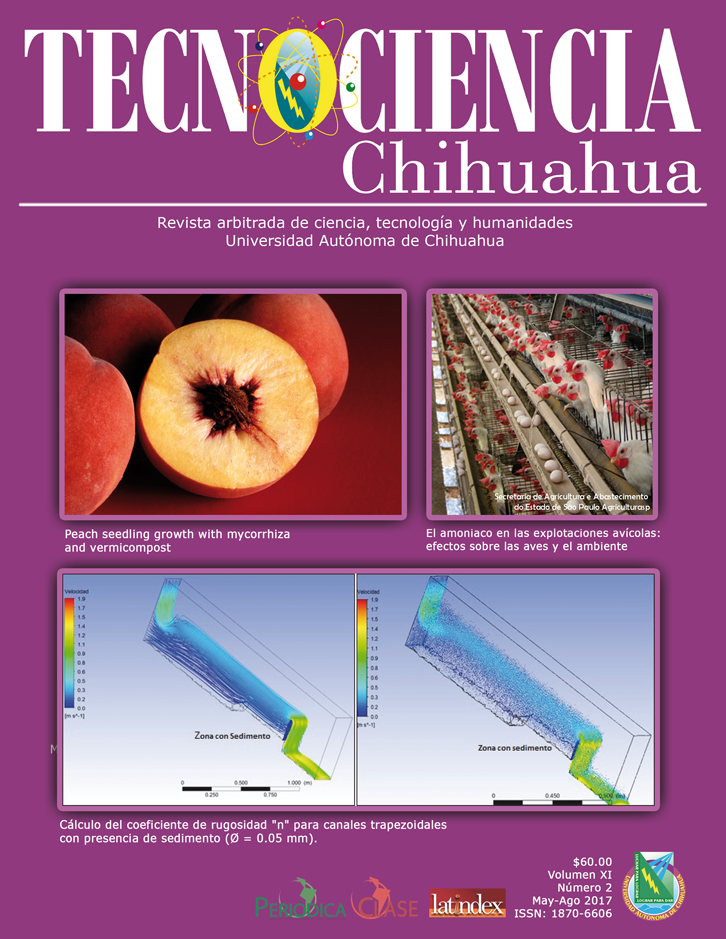Peach seedling growth with mycorrhiza and vermicompost
Crecimiento de plántulas de durazno con micorrizas y vermicomposta
DOI:
https://doi.org/10.54167/tch.v11i2.157Palabras clave:
Prunus persica (L.) Batsch, Glomus spp, fotosíntesis, fertilizante orgánicoResumen
Sterilization of nursery substrate materials decreases the beneficial microorganisms in the surrounding root media and may result in poor seedling growth; compost and arbuscular mycorrhizal fungi (AMF) may improve the plantlet development. This experiment aimed to analyze the effect of both AMF inoculation and vermicompost for the initial peach [Prunus persica (L.) Batsch.] seedling growth in sterilized substrate. Peach seedlings germinated in sterilized perlite were distributed into four resulting treatments from the combination of two factors and two levels each: with/without vermicompost in the growing media and with/without AMF inoculation at the transplanting time. Seedlings were arranged completely randomized inside a glasshouse throughout the study. Utilization of vermicompost in the growing media and AMF inoculation, and their combination, resulted in less total chlorophyll (p < 0.05) measured at 108 days after planting (DAP). At the end of the experiment (180 DAP), AMF inoculation resulted in root colonization greater than 70 % of the total root length; however, this effect was eclipsed by adding vermicompost to the substrate. Root and shoot dry weights and also stem diameter were superior (p < 0.01) by adding vermicompost to the growing substrate, but AMF inoculation had no effect on these variables. It is concluded that vermicompost addition to the substrate is preferable to AMF inoculation in order to stimulate peach seedling growth during the initial six months in sterilized substrates.
Descargas
Citas
Baldi, E., M. Toselli, G. Marcolini & B. Marangoni. 2006. Effect of mineral and organic fertilization on soil chemical, biological and physical fertility in a commercial peach orchard. Acta Horticulturae. 721: 55-62. https://doi.org/10.17660/ActaHortic.2006.721.6
Bingye, X. & Y. Shengrui. 1998. Studies on replant problems of apple and peach. Acta Horticulturae. 477: 83-88. https://doi.org/10.17660/ActaHortic.1998.477.9
Broadley, M.R., A.J. Escobar, A. Burns & I.G. Burns. 2001. Nitrogen-limited growth of lettuce is associated with lower stomatal conductance. New Phytologist 152(1): 97-106. https://doi.org/10.1046/j.0028-646x.2001.00240.x
Estaún, V., C. Calvet, A. Camprubi & J. Pinochet. 1999. Long-term effects of nursery starter substrate and AM inoculation of micropropagated peach x almond hybrid rootstock GF677. Agronomie 19(6):483-489. https://hal.archives-ouvertes.fr/hal-00885947/document
Hajiboland, R., N. Aliasgharzadech, S.F. Laiegh & C. Poschenrieder. 2010. Colonization with arbuscular mycorrhizal fungi improves salinity tolerance of tomato (Solanum lycopersicum L.) plants. Plant and Soil 331(1): 313-327 https://doi.org/10.1007/s11104-009-0255-z
Hameeda, B., G. Harini, O.P. Rupela & G. Reddy. 2007. Effect of composts or vermicomposts on sorghum growth and mycorrhizal colonization. African Journal of Biotechnology. 6(1): 9-12. https://tinyurl.com/5n9535ck
Kaschuk, G., T.W. Kuyper, P.A. Leffelaar, M. Hungria & K.E. Giller. 2009. Are rates of photosynthesis stimulated by carbon sink strength of rhizobial and arbuscular mycorrhizal symbioses? Soil Biology and Biochemestry 41(6): 1233-1244. https://doi.org/10.1016/j.soilbio.2009.03.005
Lambert, D.H., R.F. Stouffer & H. Cole Jr. 1979. Stunting of peach seedlings following soil fumigation. Journal of the American Society for Horticultural Science. 104 (4):433-435. https://doi.org/10.21273/JASHS.104.4.433
Lanzi, A., L. Incrocci, R. Pulizzi, A. Pardossi & P. Marzialetti. 2009. Evaluation of some peat-alternative substrates in horticultural crops. Acta Horticulturae. 807: 553-558. https://doi.org/10.17660/ActaHortic.2009.807.81
La Rue, J.H., W.D. Mc Clellan & W.L. Peacock. 1975. Mycorrhizal fungi and peach nursery nutrition. California Agriculture 29(5):6-7.
Lazcano, C., M. Gómez & J. Domínguez. 2008. Comparison of the effectiveness of composting and vermicomposting for the biological stabilization of cattle manure. Chemosphere. 72(7):1013-1019. https://doi.org/10.1016/j.chemosphere.2008.04.016
Linderman, R.G. & E.A. Davis. 2001. Vesicular-arbuscular mycorrhiza and plant growth response to soil amendment with composted grape pomace or its water extract. HortTechnology. 11(3): 446-450. https://doi.org/10.21273/HORTTECH.11.3.446
Manjarrez, M.J., R. Ferrera & M.C. González. 1999. Efecto de la vermicomposta y la micorriza arbuscular en el desarrollo y tasa fotosintética de chile serrano. Terra. 17(1):9-15. https://www.redalyc.org/articulo.oa?id=57317102
Moore, K.K. 2004. Growth of bedding plants in substrates amended with compost and fertilized with three different release rates of a controlled-release fertilizer product. HortTechnology. 14 (4):474-478. https://doi.org/10.21273/HORTTECH.14.4.0474
Morrison, S.J., P.A Nicholl & P.R. Hikclenton. 1993. VA mycorrhizal inoculation of landscape trees and shrubs growing under high fertility conditions. Journal of Environmental Horticulture 11: 64-71.
Navarro, A., S.P. Bañon, A. Morte & M.J. Sánchez. 2011. Effects of nursery preconditioning through mycorrhizal inoculation and drought in Arbutus unedo L. plants. Mycorrhiza 21(1): 53-64. https://doi.org/10.1007/s00572-010-0310-x
Phillips, J.M. & D.S. Hayman. 1970. Improved procedures for clearing root and staining parasitic and vesicular arbuscular mycorrhizal fungi for rapid assessment of infection. Transactions of the British Mycological Society. 55(1): 158-161. https://doi.org/10.1016/S0007-1536(70)80110-3
Plenchette, C., V. Furlan & J.A. Fortin. 1981. Growth stimulation of apple trees in unsterilized soil under field conditions with VA mycorrhiza inoculation. Canadian Journal of Botany. 59(11): 2003-2008. https://doi.org/10.1139/b81-262
Rapparini, F., R. Baraldi, G. Bertazza, B. Branzati & S. Predieri. 1994. Vesicular-arbuscular mycorrhizal inoculation of micropropagated fruit trees. Journal of Horticultural Science. 69(6): 1101-1109. https://doi.org/10.1080/00221589.1994.11516551
Raviv, M. 2005. Production of high-quality composts for horticultural purposes: a mini-review. HortTechnology 15 (1):52-57. https://doi.org/10.21273/HORTTECH.15.1.0052
Reynolds, H.L., A.E. Hartley, K.M. Vogelsang, J.D. Bever & P.A. Schultz. 2005. Arbuscular mycorrhizal fungi do not enhance nitrogen acquisition and growth of old-field perennials under low nitrogen supply in glasshouse culture. New Phytologist 167(3): 869-880. https://doi.org/10.1111/j.1469-8137.2005.01455.x
Rivière, L.M., P. Morel, J.C. Michel & S. Charpentier. 2008. Growing media in french horticulture. Acta Horticulture. 779: 33-38. https://doi.org/10.17660/ActaHortic.2008.779.1
Scagel, C.F. 2004. Soil pasteurization and mycorrhizal inoculation alter flower production and corm composition of Brodiaea laxa ‘Queen Fabiola’. HortScience. 39(6): 1432-1437. https://doi.org/10.21273/HORTSCI.39.6.1432
Suthar, S. & S. Singh. 2008. Feasibility of vermicomposting in biostabilization of sludge from a distillery industry. Science of the Total Environment 394(2-3): 237-243. https://doi.org/10.1016/j.scitotenv.2008.02.005
Traquair, J.A. & S.M. Berch. 1988. Colonization of peach rootstocks by indigenous vesicular-arbuscular mycorrhizal (VAM) fungi. Canadian Journal of Plant Science. 68(3): 893-898. https://doi.org/10.4141/cjps88-107
Tyler, H.H., S.L. Warren, T.E. Bilderback & K.B. Perry. 1993. Composted turkey litter: II. Effect on plant growth. Journal of Environment Horticulture 11(3): 137-141. https://doi.org/10.24266/0738-2898-11.3.137
Wu, Q. S. & Y.N. Zou. 2010. Beneficial roles of arbuscular mycorrhizas in citrus seedlings at temperature stress. Scientia Horticulture 125(3): 289-293. https://doi.org/10.1016/j.scienta.2010.04.001
Publicado
Cómo citar
-
Resumen284
-
PDF70
-
HTML10

















